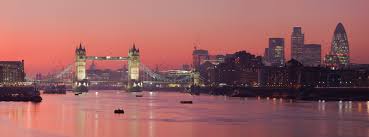Difference between revisions of "London"
From Londonhua WIKI
| (3 intermediate revisions by the same user not shown) | |||
| Line 5: | Line 5: | ||
|header1 = The London Skyline | |header1 = The London Skyline | ||
|bodystyle = width:25em | |bodystyle = width:25em | ||
| − | |image = | + | |image = [[File:London Skyline.jpg|400px]] |
| − | + | |caption = The London Skyline | |
| − | |||
| − | |||
| − | | | ||
| − | |||
| − | |||
| − | |||
| − | |||
| − | |||
}} | }} | ||
| Line 25: | Line 17: | ||
<br> | <br> | ||
| − | = | + | =Early History= |
<br> | <br> | ||
| − | + | The first incarnation of London was founded in 43 AD by Roman soldiers when they built a bridge across Thames. This bridge became the center of a port, and by 50 AD Roman merchants had built up a town around it. At the time, London was not heavily fortified, and was burned to the ground in 61 AD when Queen Boudicca of the Celts led a rebellion against the Romans. After the rebellion was put down, London was rebuilt, and by the end of the 2nd century had a twenty-foot stone wall surrounding it. By around the 3rd century, the population of London has risen to around forty-five thousand, making it the largest town in Britain. <ref> Lambert, T. (n.d.). A Brief History of London, England. Retrieved May 10, 2017, from http://www.localhistories.org/london.html | |
| + | </ref>. | ||
<br><br> | <br><br> | ||
| − | + | When the last Roman soldiers left Britain in 407 AD, London was largely abandoned. A new town was built outside its walls with a much smaller population of only ten thousand. Eventually, though, London returned to prominence. In 604 AD, a bishop was appointed to the town, and in the 640's AD a mint was constructed to produce silver coins. London rose to be a popular trading center <ref> Lambert, T. (n.d.). A Brief History of London, England. Retrieved May 10, 2017, from http://www.localhistories.org/london.html | |
| − | + | </ref>. | |
| − | |||
<br><br> | <br><br> | ||
| − | |||
| − | |||
| − | |||
=References= | =References= | ||
| − | </ | + | <references/> |
<br><br> | <br><br> | ||
| + | |||
=External Links= | =External Links= | ||
If appropriate, add an external links section | If appropriate, add an external links section | ||
Latest revision as of 06:51, 10 May 2017
London
 The London Skyline | |
| The London Skyline |
|---|
Overview
London is the capital city of England, as well as the political, economic, and cultural capital of Britain [1]. In addition to housing the largest population of any city in the United Kingdom [2], London is home to four World Heritage Sites [3], one hundred twenty-three historic buildings, thirty historic gardens, two hundred museums, and one hundred eight music halls [4].
Contents
Early History
The first incarnation of London was founded in 43 AD by Roman soldiers when they built a bridge across Thames. This bridge became the center of a port, and by 50 AD Roman merchants had built up a town around it. At the time, London was not heavily fortified, and was burned to the ground in 61 AD when Queen Boudicca of the Celts led a rebellion against the Romans. After the rebellion was put down, London was rebuilt, and by the end of the 2nd century had a twenty-foot stone wall surrounding it. By around the 3rd century, the population of London has risen to around forty-five thousand, making it the largest town in Britain. [5].
When the last Roman soldiers left Britain in 407 AD, London was largely abandoned. A new town was built outside its walls with a much smaller population of only ten thousand. Eventually, though, London returned to prominence. In 604 AD, a bishop was appointed to the town, and in the 640's AD a mint was constructed to produce silver coins. London rose to be a popular trading center [6].
References
- ↑ London - Capital of the United Kingdom. (n.d.). Retrieved May 9, 2017, from https://www.jumeirah.com/en/destinations/london/about-london/
- ↑ "The World Factbook". Central Intelligence Agency. 1 February 2014. Retrieved 9 May 2017.
- ↑ London at a Glance. (n.d.). Retrieved May 9, 2017, from http://www.visitlondon.com/things-to-do/visiting-london-for-the-first-time/london-at-a-glance#vtUzWVqPDAcxw0dK.97
- ↑ London - Capital of the United Kingdom. (n.d.). Retrieved May 9, 2017, from https://www.jumeirah.com/en/destinations/london/about-london/
- ↑ Lambert, T. (n.d.). A Brief History of London, England. Retrieved May 10, 2017, from http://www.localhistories.org/london.html
- ↑ Lambert, T. (n.d.). A Brief History of London, England. Retrieved May 10, 2017, from http://www.localhistories.org/london.html
External Links
If appropriate, add an external links section
Image Gallery
If appropriate, add an image gallery